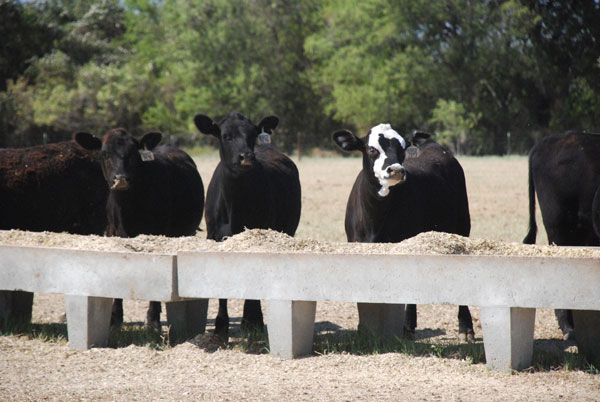Why your cows need those expensive vitamins
Are those expensive vitamins really necessary? Or just a luxury that you can get by without?
March 15, 2018

By Jaymelynn Farney
Anybody who’s strolled through the feed store or co-op lately to price mineral-vitamin mixes knows that vitamins have shot up in price. A logical question then, is this: Are vitamins necessary or just an expensive luxury that the cows can get by without?
Bottom line is yes. Vitamins, especially A and E, are important around calving.
Vitamin A is vital in cow rations in the last trimester through the first couple of months of lactation. It has been found to help manage calf scours, as colostrum is high in vitamin A, and help cows to “clean” and reduce the risk of retained placenta. To minimize calf scours, intake needs to be 30,000 to 45,000 IU per day. The actual requirement of vitamin A for pregnant cows is 1,269 IU/lb. of dry feed intake and for lactating cows 1,769 IU/lb.
Many green forages such as alfalfa are high in vitamin A, so the amount to supplement may be fairly low if feeding this forage or grazing lush, green forages. However, vitamin A can degrade in harvested forages, especially in hays that are more than a year old.
Dormant warm-season grasses are low in vitamin A, which becomes an issue for spring-calving cows, as this forage does not meet cow requirements. One good thing in regard to vitamin A is that cows can store it in the liver for up to four months, which can provide a slight cushion during vitamin A-deficient diets.
Vitamin E is important to help with selenium and vitamin A absorption, aids in immune function, and is an antioxidant important in cellular metabolism. Calves born to cows that are vitamin E-deficient can be born with white muscle disease, also a symptom of low selenium. Vitamin E requirements vary widely depending on diets, with higher vitamin E required if the diet is high in sulfur-containing amino acids, selenium, or includes oil from corn, linseed, or soybeans.
Once again, alfalfa is a good source of vitamin E for cattle, especially in the form of alfalfa meal, as well as other green, leafy forages. Whole grains also have vitamin E, particularly from the oil. There are some issues with vitamin E supply, primarily that heat and long storage length can reduce potency.
Why is it not important to feed the other fat-soluble vitamins, K and D?
Vitamins A, D, E, and K are fat-soluble, thus can be stored in the animal if fed in excess of requirements. Rumen bacteria make vitamin K in quantities sufficient to meet ruminant animal requirements, except if feeding moldy sweet clover hay or silage or any moldy legume.
Vitamin D is synthesized by sunlight in both the ruminant animal and in the forages. Cattle that have direct sunlight exposure or are fed at least 3 to 4 pounds of sun-cured hay per day do not require supplementary vitamin D. Many times, vitamins A, D, and E are sold in one “vitamin pack.” However, vitamin D is not necessarily needed unless the cattle are in a completely confined, covered facility.
What about vitamin B?
Vitamin B is a water-soluble vitamin that is synthesized by rumen microbes to meet the animal’s requirements and, therefore, does not need to be added to feed for mature animals. Baby calves do not have a functioning rumen with microbes and do not synthesize vitamin B or K.
What about baby calves?
All the vitamins mentioned above are in the colostrum of cows that have adequate vitamin levels. Subsequently, the young calf receives the vitamins from its mother. If the dam is deficient, injectable vitamins can be given to the calves. These injections are required in a series and need to be administered until the calf has a functioning rumen.
When can I remove vitamins from my supplemental feed/mineral?
Vitamins are high in green, leafy forages. Therefore, most forages during the growing season could meet cow requirements for vitamins, so offering a low level of vitamins A and E at this time provides an economical “buffer” for vitamin intake.
In the past it has been recommended to feed around 100% to 150% of vitamin A, D, and E requirements in free-choice minerals year-round, thereby ignoring the amount being supplied from forages or feeds. However, to reduce costs, cows could be provided 100% of their vitamin requirement a minimum of 45 days before calving through the first couple of months of lactation to mitigate low levels in harvested, stored forages or dormant native range, without negatively impeding performance.
What happens if no vitamins are fed?
If no vitamins are included in the diet, there is a risk of deficiencies in the cowherd, which could be presented as:
More calf scours, which is the number one cause of death in young calves
A greater number of cows not fully expelling the placenta, which results in an increased post-partum interval so more cows breed later in the season
A greater number of calves being treated for illness beyond scours
Increased occurrence of white muscle disease in newborn calves in extreme conditions.
It is important to remember that nutrition is balancing nutrients. If cow requirements for protein and energy are not met, the best quality vitamin and mineral program will not offset issues with deficiencies in energy or protein supply.
Farney is a beef systems specialist with Kansas State University
You May Also Like


.png?width=300&auto=webp&quality=80&disable=upscale)
